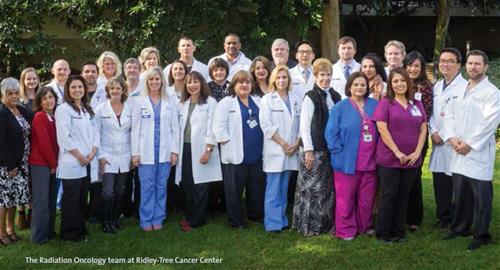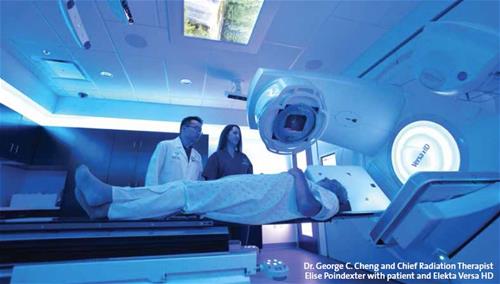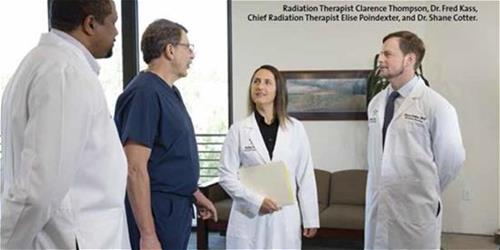
The new Ridley-Tree Cancer Center opened in September of 2017 and the Radiation Oncology department is relocating in phases from the basement of Cottage Hospital to a revolutionary space designed specifically to improve the care and comfort of patients. What will not change are the smiling attendants at their Nurse’s station post, ready to welcome you by name. They are the front lines of a department whose many contributors are often unseen while they work in secluded rooms dwarfed by massive machines. These hidden heroes are delivering care to cancer patients fighting for quality of life, or in some cases, for life itself.
Founded in 1950, the Radiation Oncology department encompasses more than 25 people including doctors, nurses, radiation therapists, physicists, biomed engineers, dosimetrists and administrative staff. The physicians and staff serve a large community of patients from all over Santa Barbara and Ventura counties. Some patients drive from even further away because they believe the quality of care is unmatched. The department maintains a well-respected reputation among premier cancer centers nationwide, utilizing the connections of its physicians to premier hospitals and academic centers of excellence.
The American Society for Radiation Oncology (ASTRO), the premier radiation oncology society in the world, recently awarded the group with accreditation for compliance with its Accreditation Program for Excellence (APEx®,) making Ridley- Tree Cancer Center the first in southern California to receive the designation. The department had to meet a list of rigorous, evidence-based standards for practicing radiation oncology and undergo a comprehensive on-site evaluation with an ASTRO team in order to become accredited. The achievement confirms the department’s commitment to a high standard of safety and quality, as well as a targeted focus on effective communication and well-coordinated treatment plans. “To do this in the midst of activating a whole new cancer center with patients under current treatment, along with other transitions and projects over the past year is truly amazing,” remarks Matthew Kunkel, vice president of oncology services for Ridley-Tree Cancer Center. “This is a testament to how wonderful a team we have.”
Dr. W. Warren Suh, medical director of the department, is proud of his colleagues’ pedigree. “We are from top institutions in terms of training and experience. You could not find a better group.” The dedication and compassion displayed by the staff is the reason he believes they consistently sail to the top of patient satisfaction surveys. “We all have the same mindset, a similar mission in mind. Our ethos is putting patients first,” says Dr.
Suh. Dr. Shane Cotter, a radiation oncologist, agrees. “When in doubt, we fit a patient in. We don’t turn anyone away. We find time to treat them. Often that means working harder or longer, but everyone pitches in. Everyone is on board,” he admits. “We recruit people that want to impact the community, to be part of it.” For many in the Radiation Oncology department, the ability to practice big-city medicine with a small-town feel is what
attracted them to this location. They like building personal relationships with their patients, running into them at the local grocery store or getting to know their family members. “Deep down, we all truly want to do what is best for the patient and I think that is what drives us and unites us,” notes Dr. Suh.
Each week, around 10 to 15 new patients arrive for treatment. There are regularly between 60 and 70 people on the roster needing radiation therapy, with most coming every day for at least six weeks. The group of nurses, led by manager Beverly Toole, RN, OCN, provides the initial education. Having the heart and the temperament to rise daily and meet patients in this very difficult, intense time is key, according to Beverly. “It’s
not what drains us, it’s what motivates us. We do the right thing when no one is looking. It’s about being present and listening and hugging. We get to take the time to love on people.” Martha Becker, RN, has close ties with Beverly and other Cancer Center oncology nurses she has worked with for nearly her entire 20-year career. It’s a privilege, she says, to become part of the lifeline for patients. “When you are faced with your mortality, it’s a scary thing. We can offer hope and friendship. You do have your ups and downs but I definitely know this is where I am supposed to be.”

Once a patient is diagnosed and assessed, the department’s dosimetrists using computer-guided software begin to create a treatment program. Their function is defined as dose measuring, evaluating all the medical information and imaging to determine how best to deliver the radiation. The process can take a half-day or a few days depending on how complex the case is. Once the plan is completed and the doctor signs off, the dosimetrists sometimes assist when the patient is placed on the machine for the first time. Dosimetrists are incredibly knowledgeable about beam placement, and actively ensure the patient is in exactly the right position. Tim Johnson’s 29 years with the department provides him with a wide range of experience to call upon when drafting a treatment plan. Drawn to the medical field at age 18 after his father died of a brain tumor, Tim’s emotion wells up when describing his work. “It’s something inside that makes you feel that you should help. You won’t cure everyone, but we can make a positive difference in patients’ lives or stop their pain. That is so worthwhile.” Partnering with Tim and Sarah Sullivan is a team of medical physicists, including Sernger Shen. This young addition to the department’s behind-the-scenes task force is focused on
quality assurance, checking every patient’s plan so it meets all the physician’s orders and proper constraints. His more recent education on the latest protocols brings a fresh perspective. Without therapeutic medical physicists or biomed engineers who at all hours carefully calibrate the radiation machines, the entire operation would screech to a halt.
The cement vaults in this department are where the rubber meets the road, where the cancer-fighting battle takes place. The giant machines can be intimidating. It falls upon the radiation therapists to not only push the buttons but counsel patients through the process. Whether someone is weak, nauseous, claustrophobic or unable to stay still, it’s the therapists’ job to keep them calm. Calling these eight staff members “techs” doesn’t give credence to a role that requires great people skills and a keen sense of emotional intuition. They are therapists in every sense of the word. “Some patients are very business-like and just want to get it done. Others need reassurance and want to talk to take their minds off it,” explains Elise Poindexter, chief radiation therapist. “I go into the room as if it could be one of my parents on the table. I try to treat every patient with the kindness that I would want for my own family.” From Rafael Rosas, nicknamed ‘Big Raffa’ because he stands more than six feet tall and escorts elderly ladies on his arm, to Peggy Thomas whose “healing touch” and loving manner helps put patients at ease, each therapist’s personality is an important piece of the puzzle. “Every one of them gives 110%,” confirms Beverly. “When I give patients a tour, I can wholeheartedly say, ‘you are going to love your therapist.’” Radiation oncology relies on each individual staff member contributing and communicating well, but Clarence Thompson is the glue. He is a radiation therapist as well as the department’s director, leading the charge for efficiency and empathy, while encouraging the bonds that develop from working long hours together. “It’s like a family. We celebrate each other’s birthdays, attend each other’s weddings, and mark the birth of children. It puts it into perspective. Patients can feel that we all care for each other.”
The move to the new Elings Oncology Building at Ridley- Tree Cancer Center prompted a look at the most cutting-edge radiation technology available. After a lengthy research project by staff and the department’s radiation oncologists, they secured the purchase of two new, multimillion-dollar Elekta Versa High Definition™ linear accelerators, so big they had to be delivered on multiple flat-bed trucks. These sophisticated machines, similar to those found at MD Anderson, UCSF and Johns Hopkins cancer centers, deliver a CT scan image and radiation simultaneously, making treatments more accurate. “The more anatomy you can see on that scan, the better. We put a lot of thought and effort into evaluating the different options available. The radiation technology in the new building is among the most advanced in the world,” says Elise. Another innovative upgrade in the radiation oncology wing of the new building is a state-of-the-art Sentient light and sound package for the treatment suites. Using an iPad-like device, patients will be able to play their own music, and select which colors and peaceful images project on the ceiling screens. “The goal is to help patients be more relaxed, to relieve anxiety,” suggests Beverly, who spearheaded the acquisition. “Perhaps they will have a positive experience, and it’s one thing they
can control.”
This combination of a staff dedicated to patient care and the financial means to afford the latest machinery, is the best of both worlds, according to Dr. Suh. “It’s a wonderful blessing to be in a community of this size with all the resources that you typically have in a large academic center,” he notes.

The special rituals the staff employ keep the mood light even if the work is serious. Events like a bell-ringing, confetti-throwing ceremony once treatment is complete and celebrations with food, decorations and costumes for every holiday on the calendar provide something happy and fun to look forward to. “We do spend a lot of time talking about the technology, but how we interact with those we serve, how they feel about their time here, that is what makes the difference,” affirms Dr. Cotter.
More than half of cancer patients now receive radiation as a curative treatment up front, or as a palliative treatment later on, according to the National Cancer Institute. Drs. Suh
and Cotter attribute this to a demographic trend, with more people living longer and more options for less invasive medical solutions. On both fronts, radiation oncology is likely to be a field more in demand. Success for this staff though will not be determined by a rising caseload. Rather, the numbers of patients and their relatives who return long after their radiation course to give thanks, or visit a while, is the truest sign of a job well done. “We know that there will be better, happier days because we’ve seen it. We try to give them hope,” offers Dr. Suh. “When patients come back later and want to thank
everyone here for helping them get through a tough time. That is the gratifying part."